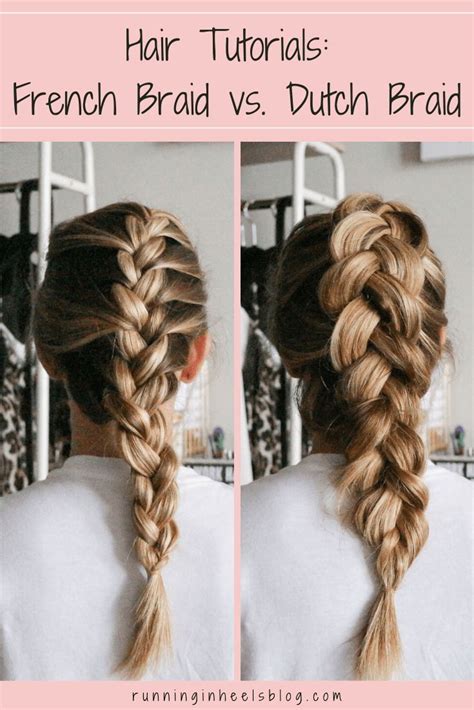Introduction

Intricate and captivating, Dutch braids and French braids have become staples in the hairstyling repertoire across cultures. Both techniques evoke an air of elegance and sophistication, captivating onlookers with their unique patterns and versatility. In this comprehensive article, we delve into the intricate details of these two beloved braiding methods, exploring their similarities, differences, and the myriad of applications that have propelled them to timeless status.
Understanding Dutch Braids: A Bold and Expressive Approach
Origin and History
Dutch braids, also known as inverted braids or pancake braids, have their roots in Dutch culture, specifically the Frisian region. The technique gained widespread popularity in the 19th century and has since become a beloved hairstyling choice.
Technique
The essence of a Dutch braid lies in its “inside-out” approach. Unlike traditional braids where strands are crossed over each other, Dutch braids involve crossing strands under each other. This inverted technique creates a raised, prominent effect, adding volume and texture to the hair.
Characteristics
- 3-Strand Base: Dutch braids are constructed using three sections of hair, similar to French braids.
- Raised Effect: The underhand crossing technique produces a lifted, almost 3D effect, creating a visually striking braid.
- Structured Appearance: Dutch braids convey a sense of neatness and control due to their tight and precise construction.
- Versatile Styling: These braids can be styled into a variety of shapes and sizes, from intricate buns to whimsical headbands.
French Braids: A Classic of Grace and Elegance
Origin and History
French braids have a rich history dating back to the 15th century, with their roots in French aristocracy. The style became popular among women of all classes and has remained a timeless classic in hair fashion.
Technique
French braids, also known as overhand braids, follow a traditional braiding pattern. The technique involves crossing outer strands of hair over the center strand, creating a smooth and intricate braid.
Characteristics
- 3-Strand Base: Similar to Dutch braids, French braids are composed of three strands of hair.
- Flattened Appearance: The overhand crossing technique results in a flatter, more delicate braid compared to Dutch braids.
- Romantic and Feminine: French braids exude a sense of romance and femininity, often associated with graceful and sophisticated hairstyles.
- Versatile Applications: These braids are equally suitable for everyday wear, formal occasions, and bridal updos.
Comparative Analysis: Dutch Braids vs French Braids
Table 1: Key Differences
| Feature | Dutch Braids | French Braids |
|---|---|---|
| Technique | Inside-out crossing | Overhand crossing |
| Effect | Raised, voluminous | Flattened, delicate |
| Appearance | Structured, bold | Romantic, feminine |
| Versatility | Suitable for various styles | Suitable for formal and casual wear |
Table 2: Textural Contrasts
| Texture | Dutch Braids | French Braids |
|---|---|---|
| Tightness | Tight, secure | Loose, flowing |
| Shine | Glossy, prominent | Smooth, subtle |
| Volume | High volume | Moderate volume |
Step-by-Step Instructions: Dutch and French Braiding Techniques
Dutch Braid
- Section Hair: Divide the hair into three equal sections.
- Cross Under: Take the right section and cross it under the center section.
- Add Left: Take the left section and cross it under the new center section (which was previously the right).
- Repeat: Continue alternating right and left sections, crossing them under the center.
- Secure: Once all hair is braided, secure the end with an elastic band.
French Braid
- Section Hair: Divide the hair into three equal sections.
- Cross Over: Take the right section and cross it over the center section.
- Add Left: Take the left section and cross it over the new center section (which was previously the right).
- Extend: As you braid, pick up small sections of hair from the sides and incorporate them into your outer strands.
- Secure: Once all hair is braided, secure the end with an elastic band.
Creative Applications and Style Inspirations
Dutch and French braids offer endless possibilities for creativity. Here are a few innovative applications:
- Braided Headbands: Transform a basic headband by braiding the hair and wrapping it around the head.
- Braided Buns: Elevate a simple bun by incorporating Dutch or French braids into its construction.
- Braided Crown: Create a whimsical crown by braiding hair around the head and securing it with bobby pins.
- Braided Bridal Hairstyles: Dutch and French braids are popular choices for bridal updos, adding a touch of elegance and sophistication.
- Braided Accessories: Create unique hair accessories by braiding yarn, ribbon, or other materials into decorative elements.
Practical Considerations: Maintenance and Etiquette
Maintenance
- Brush hair regularly to prevent tangles.
- Braid hair when slightly damp for better hold.
- Use hairspray or mousse to secure and set the braid.
- Protect braids from excessive rain or humidity.
Etiquette
- Respect hair extensions and wigs when braiding.
- Avoid braiding hair too tightly, as it can cause discomfort.
- Consult a professional hair stylist for intricate or complex braiding techniques.
Conclusion
Dutch braids and French braids are two timeless hairstyling techniques that continue to captivate and inspire. Their versatility, elegance, and ease of creation make them suitable for any occasion. Whether you prefer the bold and expressive nature of Dutch braids or the romantic and graceful charm of French braids, both styles offer endless possibilities for creativity and self-expression. With the insights and guidance provided in this article, you can confidently experiment with these braiding techniques and elevate your hairstyle to new heights of beauty and sophistication.
